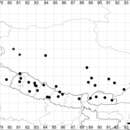Description
provided by Phytokeys
Annual up to 25 cm with several or numerous prostrate or ascending stems. Leaves farinose, shortly petiolate (petioles up to 1.5 cm but usually much smaller) with blades up to 2 cm, rhombic or ovate, entire or subhastate. Inflorescence leafy almost to the top. Flowers in glomerules arranged in ± dense inflorescence. Perianth farinose. Fruits and seeds heteromorphic. The first type of fruits and seeds is formed in terminal flowers, the fruits ripen in July-August. These fruits are ca. 1 mm in diameter and 0.5 mm thick; pericarp with papillae up to 20(25) μm (Fig. 4C); seed dark red or blackish with median keel (Fig. 4E, F), testa 17–25 μm thick. Fruits of the second type (which dominates at the end of the vegetation period) are ovoid, 1.0–1.2 mm long, ca. 0.5 mm thick, pericarp papillate or not (Fig. 4D); seeds yellow-brownish, elongated.
- license
- cc-by-3.0
- copyright
- Alexander P. Sukhorukov, Pei-Liang Liu, Maria Kushunina
- bibliographic citation
- Sukhorukov A, Liu P, Kushunina M (2019) Taxonomic revision of Chenopodiaceae in Himalaya and Tibet PhytoKeys (116): 1–141
- author
- Alexander P. Sukhorukov
- author
- Pei-Liang Liu
- author
- Maria Kushunina

